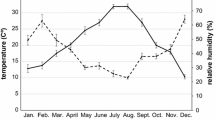Abstract
Long-term (1995–2003) population dynamics of ixodid ticks and their main hosts (small mammals) and conditions providing for the formation of tick-borne encephalitis (TBE) foci were studies in the middle taiga subzone (Karelia). The results show that the bank vole (Clethrionomys glareolus Schr.) is the main host for the larvae and nymphs of Ixodes persulcatus Schulze, 1930 and for the larvae, nymphs, and adult individuals of I. trianguliceps Birula, 1895. The proportion of ticks feeding on this species (relative to their total number) reaches 63.3% (64.0% of I. persulcatus and 61.1% of I. trianguliceps). Activity of a TBE focus is determined primarily by the abundance of bank voles of older age groups.
Similar content being viewed by others
References
Beklemishev, V.I., Terms and Concepts Necessary for Studies on Populations of Ectoparasites and Nidicolous Parasites, Zool. Zh., 1961, vol. 40, no. 2, pp. 149–158.
Bespyatova, L.A., Ticks and Gamasid Mites Parasitizing Small Mammals in the Natural Focus of Tick-Borne Encephalitis in Southern Karelia, in Aktual’nye voprosy meditsinskoi parazitologii: Tez. dokl. (Current Problems in Medical Parasitology. Abstracts of Papers), St. Petersburg, 1998, pp. 65–66.
Bobrovskikh, T.K., Iksodovye kleshchi Karelii (Karelian Ixodid Ticks), Petrozavodsk: Karel. Fil. Akad. Nauk SSSR, 1989.
Chunikhin, S.P., Experimental Research on the Ecology of Tick-Borne Encephalitis Virus, Vopr. Virusol., 1990, no. 3, pp. 183–188.
Gosudarstvennyi doklad o sostoyanii okruzhayushchei prirodnoi sredy Respubliki Karelii, 1992–2003 gg. (State Report on the State of Natural Environment in the Republic of Karelia, 1992–2003), Petrozavodsk, 1993–2004.
Ivanter, E.V., Populyatsionnaya ekologiya melkikh mlekopitayushchikh taezhnogo Severo-Zapada SSSR (Population Ecology of Small Mammals in the Taiga Zone of the North-western Soviet Union), Leningrad: Nauka, 1975.
Karaseva, E.V. and Anan’in, V.V., Main Features of a Natural Lacustrine-Bog Focus of Benign Leptospirosis, Zool. Zh., 1954, vol. 72, no. 5, pp. 113–122.
Kheisin, E.M., On the Northern Boundary of Ticks Distribution in the Karelian-Finnish ASSR, Zool. Zh., 1950, vol. 29, no. 6, pp. 572–574.
Kislenko, G.K., Korotkov, Yu.S., and Chunikhin, S.P., Small Mammals in Natural Foci of Tick-Borne Encephalitis in Central Siberia: 1. Proportion of Animals Immune to the Agent of Infection among Insectivores and Rodents, Med. Parazitol., 1994, no. 4, pp. 45–51.
Korenberg, E.I., Assessment of the Epizootic Situation in Leptospirosis by Pathological Changes in Voles, Zh. Mikrobiol. Epidemiol. Immunobiol., 1964, no. 5, pp. 87–92.
Kovalevskii, Yu.V., Korenberg, E.I., and Gorelova, N.B., Long-term Dynamics of the Epizootic Process in Natural Foci of Tick-Borne Borrelioses in Mountain Taiga Forests of the Middle Urals, Parazitologiya, 2004, vol. 38, no. 2, pp. 105–120.
Lutta, A.S., Parasitological Situation with Tick-Borne Encephalitis in Karelia, in Biologicheskie osnovy bor’by s transmissivnymi i parazitamymi zabolevaniyami na Severe (Biological Principles of Transmissible and Parasitic Disease Control in the North), Petrozavodsk, 1972, pp. 141–149.
Lutta, A.S., Kheisin, E.M., and Shul’man, R.E., On the Distribution of Ticks in Karelia, in Voprosy parazitologii Karelii (Problems of Parasitology in Karelia), Petrozavodsk, 1959, pp. 72–83.
Naumov, R.L., Chunikhin, S.P., and Gutova, E.N., Experimental Study of Interactions between Vertebrates and Tick-Borne Encephalitis Virus: 2. Small Mammals, Medits. Parazitol, 1984, no. 2, pp. 83–86.
Okulova, N.M., Chunikhin, S.P., and Vavilova, V.E., Correlations between Parameters of Tick-Borne Encephalitis Morbidity and Some Natural Factors in Primorye, Zh. Mikrobiol., 1982, no. 1, pp. 63–67.
Author information
Authors and Affiliations
Additional information
Original Russian Text © L.A. Bespyatova, E.P. Ieshko, E.V. Ivanter, S.V. Bugmyrin, 2006, published in Ekologiya, 2006, No. 5, pp. 360–364.
Rights and permissions
About this article
Cite this article
Bespyatova, L.A., Ieshko, E.P., Ivanter, E.V. et al. Long-term population dynamics of ixodid ticks and development of tick-borne encephalitis foci under conditions of the middle taiga subzone. Russ J Ecol 37, 325–329 (2006). https://doi.org/10.1134/S1067413606050055
Received:
Issue Date:
DOI: https://doi.org/10.1134/S1067413606050055




